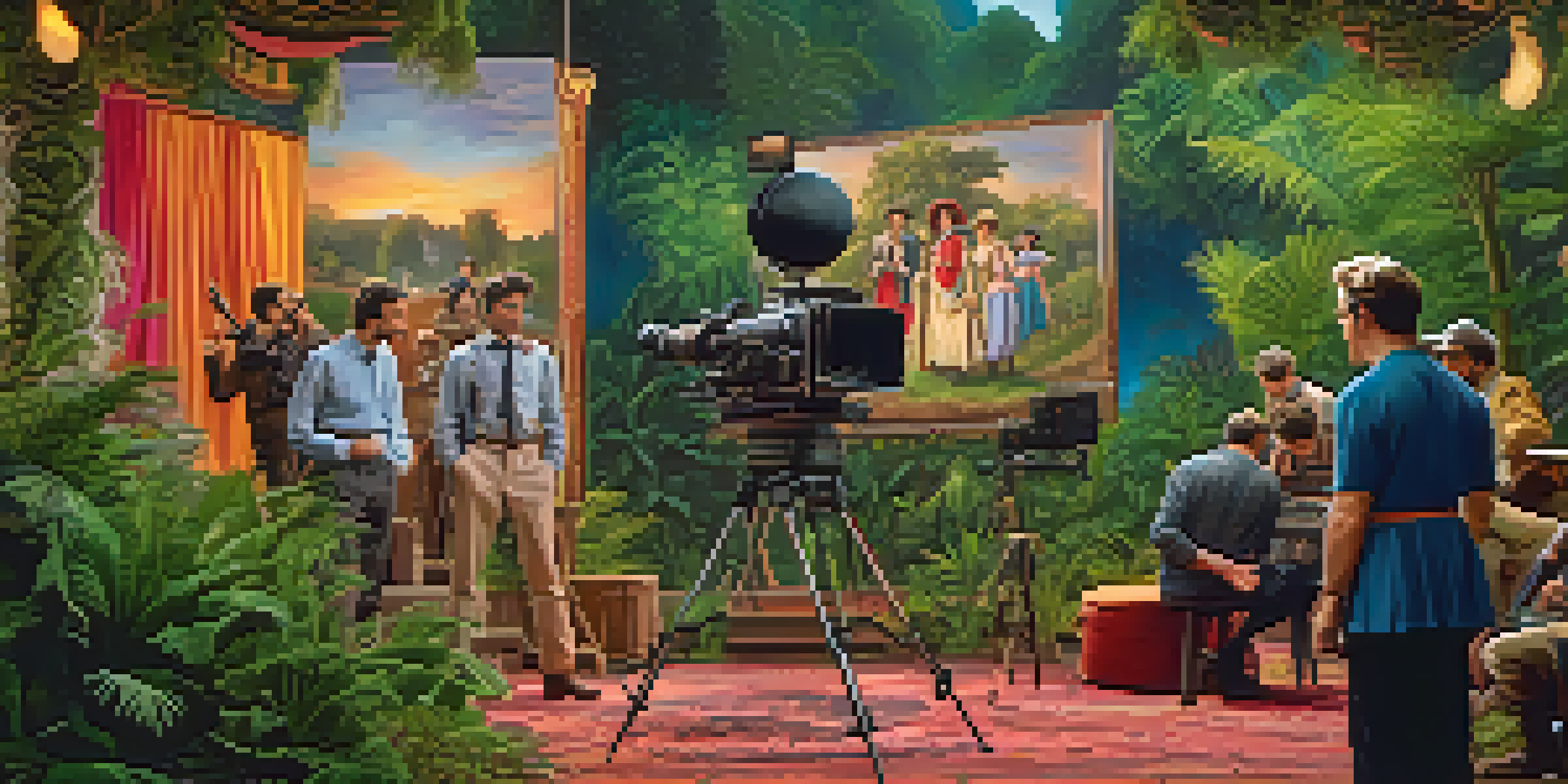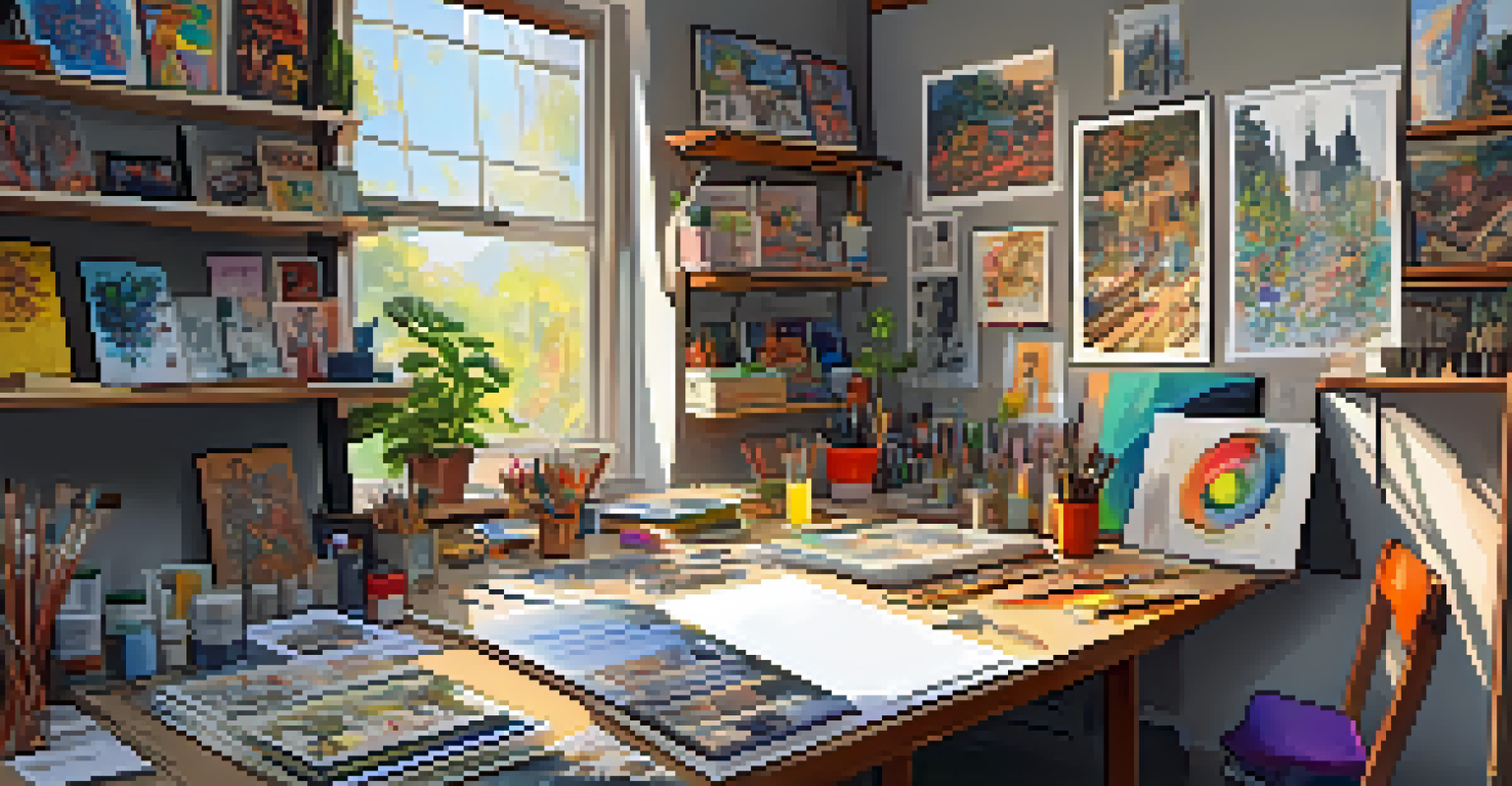The Evolution of Adaptations: Trends in Hollywood Storytelling

The Rise of Adaptations in Film History
Adaptations have been a staple in Hollywood since the dawn of cinema, with filmmakers drawing inspiration from novels, plays, and even video games. This trend can be traced back to classics like "Gone with the Wind" and "The Wizard of Oz," which captivated audiences with their rich narratives. As storytelling evolved, so did the mediums from which these adaptations were sourced, reflecting changes in cultural interests and technological advancements.
Adaptation is a kind of translation, and translation is always a negotiation between the original and the new context.
The appeal of adaptations lies in their ability to take familiar stories and recontextualize them for new audiences. This connection between the original material and its cinematic interpretation often creates a sense of nostalgia, while also allowing for fresh perspectives. For example, adaptations of Shakespeare's works have been reimagined in various settings, from modern-day high schools to dystopian futures, showcasing the timelessness of his themes.
As we move into the 21st century, adaptations continue to dominate box offices, with franchises like the Marvel Cinematic Universe drawing heavily from comic books. This trend not only reflects a demand for recognizable content but also highlights a shift in how stories are told and consumed, paving the way for innovative storytelling techniques.
The Shift Toward Diverse Source Material
In recent years, Hollywood has expanded its adaptation toolkit, embracing a wider array of source material. No longer limited to classic literature or popular novels, filmmakers are now drawing inspiration from graphic novels, podcasts, and even social media trends. This shift signals a growing recognition of diverse narratives and voices, which resonate with a broader audience.

For instance, the adaptation of graphic novels such as "The Walking Dead" has not only brought new stories to life but has also introduced unique visual styles that captivate viewers. Additionally, films like "Crazy Rich Asians" showcase the richness of cultural storytelling, highlighting the importance of representation in mainstream media. This trend not only enriches the cinematic landscape but also fosters a sense of inclusion.
Adaptations Reflect Cultural Shifts
Filmmakers are increasingly drawing from diverse source materials, showcasing stories that resonate with a broader audience.
By venturing beyond traditional adaptations, Hollywood is finding new ways to engage audiences and challenge storytelling norms. This evolution allows for innovative approaches that can blend genres and formats, creating a dynamic viewing experience that appeals to diverse demographics.
The Impact of Streaming Services on Adaptations
The rise of streaming services has significantly transformed the landscape of adaptations in Hollywood. Platforms like Netflix and Hulu have become powerhouses for bringing literary works to the screen, often producing series that delve deeper into source material than traditional films. This allows for more complex character development and nuanced storytelling, which viewers increasingly crave.
The best adaptations are those that respect the source material while also bringing something new to the table.
Take, for example, Netflix's adaptation of "The Witcher," which expanded on the original book series and video games, offering fans a richer narrative experience. Such adaptations not only attract existing fans but also introduce new audiences to the original material. This symbiotic relationship between platform and content has created a thriving environment for adaptations.
Moreover, the flexibility of streaming allows for longer runtimes and diverse storytelling formats, such as limited series or anthologies. This innovation means that adaptations can explore themes and subplots that might be overlooked in a standard film format, leading to more satisfying narratives and deeper viewer engagement.
Nostalgia and the Reboot Culture
Nostalgia is a powerful driving force in Hollywood, contributing to the popularity of reboots and adaptations of beloved classics. Films and series from the past are being revisited and reimagined for modern audiences, often with a fresh take that resonates with current societal issues. This trend reflects a longing for simpler times, while also seeking to address contemporary realities.
For instance, the recent adaptations of shows like "Fuller House" and "The Fresh Prince of Bel-Air" have tapped into the nostalgia of original viewers while introducing new storylines and characters. This dual approach not only garners attention from longtime fans but also appeals to younger generations who are discovering these stories for the first time.
Streaming Services Transform Adaptations
The rise of streaming platforms allows for deeper storytelling and character development, enhancing the adaptation experience.
However, this reboot culture also sparks debates about creativity and originality in Hollywood. While nostalgia can be comforting, it raises questions about the industry's reliance on past successes rather than fostering new ideas. Striking the right balance between honoring beloved content and pushing creative boundaries remains a challenge in the ever-evolving landscape of adaptations.
The Role of Audience Expectations
As adaptations continue to flourish, audience expectations play a crucial role in shaping how stories are told. Fans often come with preconceived notions about characters, plots, and even the tone of the adaptation based on their experiences with the source material. This can create a double-edged sword for filmmakers who aim to please both loyal fans and newcomers.
For example, adaptations like "Game of Thrones" faced immense scrutiny from fans who had high expectations based on George R.R. Martin's intricate novels. While the series garnered critical acclaim, it also sparked debates over character arcs and plot choices, illustrating the challenges of meeting diverse audience expectations. Filmmakers must navigate this tightrope, balancing fidelity to the source material while also allowing for creative license.
Ultimately, audience engagement has become a significant factor in the adaptation process. Social media platforms now serve as a space for fans to voice opinions, share theories, and influence potential sequels or spin-offs. This interaction not only shapes future adaptations but also reinforces the notion that storytelling is a collaborative experience between creators and their audience.
Innovations in Storytelling Techniques
The evolution of adaptations has also led to exciting innovations in storytelling techniques. Modern filmmakers are experimenting with narrative structures, visual styles, and technology to create captivating adaptations that push the boundaries of traditional storytelling. This evolution reflects a desire to engage audiences on multiple levels, creating a richer viewing experience.
One notable example is the use of non-linear storytelling in adaptations like "The Handmaid's Tale," which offers viewers a layered understanding of the narrative through flashbacks and multiple perspectives. This technique not only enhances the complexity of the story but also invites audiences to think critically about the themes being explored. Such innovations can transform familiar narratives into thought-provoking experiences.
Nostalgia Fuels Reboot Culture
Hollywood's tendency to revisit classic stories taps into audience nostalgia while raising questions about creativity and originality.
Moreover, advancements in technology, such as virtual reality and augmented reality, are beginning to influence adaptations as well. These tools provide immersive experiences that allow audiences to engage with stories in ways that were previously unimaginable, further blurring the lines between creator and viewer. As technology continues to evolve, it will undoubtedly shape the future of adaptations and the storytelling landscape.
Looking Ahead: The Future of Adaptations
As we look to the future, the landscape of adaptations is poised for continued evolution. With a growing emphasis on diverse narratives and innovative storytelling techniques, there are boundless opportunities for filmmakers to explore new frontiers. The challenge will be to strike a balance between honoring source material and creating original content that resonates with audiences.
In addition, the ongoing impact of technology and streaming platforms will likely continue to shape the way adaptations are produced and consumed. As audiences become more discerning and engaged, filmmakers will need to adapt their approaches to meet these evolving expectations. This dynamic interplay will foster a creative environment ripe for new ideas and narratives.

Ultimately, the future of adaptations in Hollywood is bright, with the potential to inspire and captivate audiences across generations. By embracing change and innovation, filmmakers can continue to tell stories that not only entertain but also reflect the diverse world we live in, ensuring that adaptations remain a vital part of the storytelling landscape.